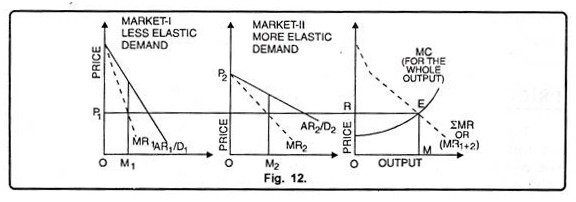The aim of monopolist is to increase total revenue and profit. Under price discrimination, the monopolist will charge different prices in different sub-markets.
Suppose, the monopolist has two different markets having different elasticity of demand.
He has to take following three decisions in order to maximize his profits:
1. How much output should be produced?
ADVERTISEMENTS:
2. How to divide total output between two different markets?
3. What price should be charged in each market?
Now, let us examine these decisions in detail as per Figure 12.
1. How much Total Output should be Produced?
Since it is assumed that the product is homogeneous, the monopolist must consider his marginal cost (MC) for the whole output irrespective of which market it is sold in. He equates this marginal cost (MC) with the composite (combined) marginal revenue curve (ZMR) from both markets-market-I and market-II. The composite (combined) marginal revenue curve (ZMR) is found by adding the marginal revenue curves of Market-I and Market-II, horizontally.
ADVERTISEMENTS:
The composite marginal revenue curve (combined marginal revenue curve) is represented as 2MR or CMR. Thus total output is fixed at the point where MC = CMR (or ZMR). Thus, in the diagram 12, the monopolist will produce OM amount of output. At this output, the addition to his cost of producing the last unit is just equal to the addition to his revenues from selling that unit in either market.
2. How to Divide Total Output between Two Markets:
The monopolist will maximize his profits by equating the MC of the whole output with the MR in Market I (MR1) and MC of the whole output with the MR in Market II (MR2). In other words, the total output (OM) is divided between two markets in such a way that marginal revenue in each is equal to the marginal cost for the whole output which is also equal to the composite (combined) marginal revenue at OR.
This means he will sell OM1 output in market-I and OM2 output in market-II and the combined output at price OR (where ZMR equals marginal cost for the whole output) is obtained by adding the output in market-I and market-II at OR. MR must be the same in both the markets – (i.e., MR1 = MR2) for it has to be equated with the same MC (i.e., the marginal cost for the whole output) which is also equal to OR. In any case, if it were not the same, the monopolist could increase profits by transferring output from where marginal revenue was lower to where it was higher.
3. What Price should be Charged in Each Market?
ADVERTISEMENTS:
Since the elasticity’s of demand are different in each market, the monopolist will charge different prices in both the markets to maximize his profits. The price in market-I with less elastic demand will be higher than the price in market-II with more elastic demand.
An output OM1 will be sold at OP1 price in market-1; an output OM2 will be sold at OP2 price in market- II. The prices are different in both the markets (i.e., OP1 = OP2), since the demand is less elastic in market-I than in market II; hence, a smaller quantity can be sold at higher price in market-I than the market-II.
The monopolist will be in equilibrium, where MR1 = MR2 = CMR = MC (for the whole output). It is this distribution where the monopolist maximizes his profits or it is this point where the monopolist earns maximum profits. The monopolist is said to be in equilibrium.
